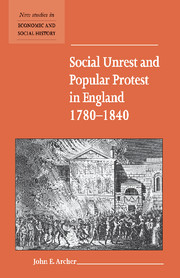Book contents
7 - A revolutionary challenge?
Published online by Cambridge University Press: 05 July 2015
Summary
The question of how close England came to revolution has been addressed by most historians working on this period. There is a general consensus that these decades possessed a revolutionary potential and, furthermore, that the country came as close as it had ever been to revolution since the seventeenth century. The consensus breaks down, however, when these scholars come to identify the most revolutionary year. Wells has pointed to the war years, especially 1799–1801 (1989: 32), Darvall to the Luddite year of 1812 (1969), White to the post-war period of 1817–19 (1968), whilst for E. P. Thompson Britain was ‘within an ace of revolution’ between 1831 and 1832 (1968: 898). Between these revolutionary ‘moments’ were interspersed individual events which were insurrectionary in character but lacking mass popular support. The naval mutinies of 1797, the Despard Conspiracy, Pentrich and Grange Moor, and Cato Street, for example, were in retrospect rather feeble attempts that in some cases were exaggerated by contemporaries, not least government spies and agents provocateurs. Consequently, some historians – such as Dickinson, Dinwiddy, Thomis and Holt – have been distinctly unimpressed by the proximity of revolution. Even the more sceptical of them allow that ‘an idea of revolution, elusive in time and space, shape and form’ (Thomis and Holt 1977: 1) did exist but that some of the schemes were wildly impractical and represented the hopes and ambitions of but a tiny minority. This raises the problem of definition as to what is meant by the term ‘revolution’. As Stevenson has emphasised (1992: 326–30), England did not experience a revolution between the 1790s and 1840 and it is virtually impossible to judge how close the nation came to one since historians would not necessarily be able to identify a revolutionary situation. Popular direct action and mass mobilisation should not be confused with revolution or revolutionary potential.
- Type
- Chapter
- Information
- Social Unrest and Popular Protest in England, 1780–1840 , pp. 89 - 93Publisher: Cambridge University PressPrint publication year: 2000

